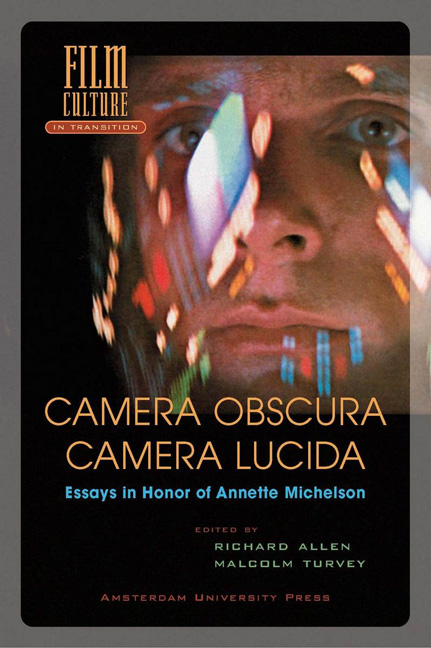Book contents
- Frontmatter
- Contents
- Acknowledgements
- Preface
- Introduction
- The Logic of an Illusion: Notes on the Genealogy of Intellectual Cinema
- Narcissistic Machines and Erotic Prostheses
- Loïe Fuller and the Art of Motion: Body, Light, Electricity and the Origins of Cinema
- Visitings of Awful Promise: The Cinema Seen from Etna
- Transfiguring the Urban Gray: László Moholy-Nagy’s Film Scenario ‘Dynamic of the Metropolis’
- Eisenstein’s Philosophy of Film
- Knight’s Moves
- Hitchcock and Narrative Suspense: Theory and Practice
- From the Air: A Genealogy of Antonioni’s Modernism
- Dr. Strangelove: or: the Apparatus of Nuclear Warfare
- Collection and Recollection: On Film Itineraries and Museum Walks
- Afterward: A Matter of Time: Analog Versus Digital, the Perennial Question of Shifting Technology and Its Implications for an Experimental Filmmaker’s Odyssey
- Select Bibliography
- List of Contributors
- Index
- Film Culture in Transition General Editor: Thomas Elsaesser
Knight’s Moves
Published online by Cambridge University Press: 25 January 2021
- Frontmatter
- Contents
- Acknowledgements
- Preface
- Introduction
- The Logic of an Illusion: Notes on the Genealogy of Intellectual Cinema
- Narcissistic Machines and Erotic Prostheses
- Loïe Fuller and the Art of Motion: Body, Light, Electricity and the Origins of Cinema
- Visitings of Awful Promise: The Cinema Seen from Etna
- Transfiguring the Urban Gray: László Moholy-Nagy’s Film Scenario ‘Dynamic of the Metropolis’
- Eisenstein’s Philosophy of Film
- Knight’s Moves
- Hitchcock and Narrative Suspense: Theory and Practice
- From the Air: A Genealogy of Antonioni’s Modernism
- Dr. Strangelove: or: the Apparatus of Nuclear Warfare
- Collection and Recollection: On Film Itineraries and Museum Walks
- Afterward: A Matter of Time: Analog Versus Digital, the Perennial Question of Shifting Technology and Its Implications for an Experimental Filmmaker’s Odyssey
- Select Bibliography
- List of Contributors
- Index
- Film Culture in Transition General Editor: Thomas Elsaesser
Summary
‘Experimental film,’ ‘Pure Film,’ ‘Underground film,’ ‘Co-op film,’ ‘Avantgarde film,’ ‘Counter-cinema’… How distant all these terms seem from the vantage point of today – how dated, how nostalgic, how difficult to explain. I am afraid that, to make sense of them, I shall have to be shamelessly autobiographical, to go back over forty years or more in order to puzzle out the complex and confusing ways in which the theory and practice of avant-garde cinema developed and changed. ‘Memory Lane’ is always a treacherous path to follow, but it would be pointless to pretend that I was somehow an outsider looking back dispassionately on the intricate debates that flourished in the world of experimental film, during the 1970s in particular. Of course, these debates did not spring up from nowhere. The form they took was determined by a long previous history going back many decades and also by expectations of the future – this was a time in which I (and others) wrote drafts of guidelines for possible futures under the pretext of theorizing contemporary film practice, looking for alternative ways of filmmaking.
It is futile – probably impossible – to try and define all the distinctions we might like to make between categories such as ‘experimental film,’ ‘avantgarde film,’ ‘underground film,’ ‘co-op film,’ ‘counter-cinema’ (my very own contribution) and so on. The history of experimental film is broken and diverse – rather as in Victor Shklovsky's image, it proceeded by knight's moves, going forward much of the time but always obliquely, sometimes aggressive, sometimes defensive according to a strategy that was always difficult to define and second-guess. There are, however, some constants. Experimental film did not develop in an artistic vacuum; as well as its contrasts and connections with the commercial cinema, experimental film also had connections and contrasts with the other arts – painting, of course (itself a visual art), as well as music (another time-based art) and even poetry, particularly ‘imagist poetry’ but also ‘typographic poetry.’ In particular, the influence of painting and music often pushed experimental film towards animation as a working method and abstraction as a goal – Eggeling, Richter, Fischinger, MacLaren, the Whitney brothers, and many, many others.
Experimental film has had a long history, spanning the entire twentieth century.
- Type
- Chapter
- Information
- Camera Obscura, Camera LucidaEssays in Honor of Annette Michelson, pp. 147 - 162Publisher: Amsterdam University PressPrint publication year: 2003



